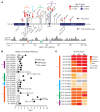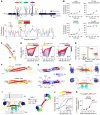CERT1 mutations perturb human development by disrupting sphingolipid homeostasis
- PMID: 36976648
- PMCID: PMC10178846
- DOI: 10.1172/JCI165019
CERT1 mutations perturb human development by disrupting sphingolipid homeostasis
Erratum in
-
Corrigendum to CERT1 mutations perturb human development by disrupting sphingolipid homeostasis.J Clin Invest. 2025 Nov 3;135(21):e200195. doi: 10.1172/JCI200195. eCollection 2025 Nov 3. J Clin Invest. 2025. PMID: 41178725 Free PMC article. No abstract available.
Abstract
Neural differentiation, synaptic transmission, and action potential propagation depend on membrane sphingolipids, whose metabolism is tightly regulated. Mutations in the ceramide transporter CERT (CERT1), which is involved in sphingolipid biosynthesis, are associated with intellectual disability, but the pathogenic mechanism remains obscure. Here, we characterize 31 individuals with de novo missense variants in CERT1. Several variants fall into a previously uncharacterized dimeric helical domain that enables CERT homeostatic inactivation, without which sphingolipid production goes unchecked. The clinical severity reflects the degree to which CERT autoregulation is disrupted, and inhibiting CERT pharmacologically corrects morphological and motor abnormalities in a Drosophila model of the disease, which we call ceramide transporter (CerTra) syndrome. These findings uncover a central role for CERT autoregulation in the control of sphingolipid biosynthetic flux, provide unexpected insight into the structural organization of CERT, and suggest a possible therapeutic approach for patients with CerTra syndrome.
Keywords: Cell Biology; Genetics; Lipid rafts; Neurodevelopment.
Figures






References
Publication types
MeSH terms
Substances
Grants and funding
LinkOut - more resources
Full Text Sources
Molecular Biology Databases
Miscellaneous

